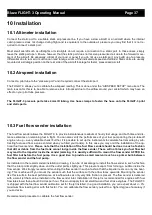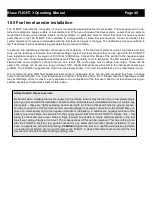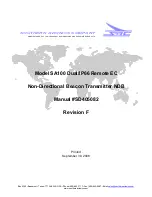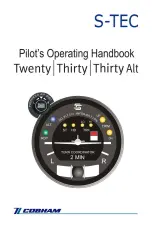
Blaze FLIGHT-3 Operating Manual
Page 38
Note:
You must disable the fuel level sender if you have one installed, and enable the calculated fuel level sender.
1. Fill your tank exactly to a known level (for example 50 Litres).
2. Set your fuel level to 50 Litres.
3. Fly your aircraft for a period that you know will use approximately 20 Litres of fuel. The exact fuel burn is not im -
portant; just burn about 20 Litres of your fuel. At the end of your flight the instrument should give you a reading of
how much fuel you have left – the reading should be about 30 Litres left.
4. Now place your aircraft in exactly the same position that you used when you first filled the tank and refill the tank
to 50 Litres using a measuring jug. You should find that you need 20 Litres of fuel to refill to 50 Litres.
5. If you find that the instrument under or over reads the fuel used, you should perform a simple adjustment of the
fuel flow sender calibration factor.
Example:
Actual fuel used: 21.5 Litres, FLIGHT-3 fuel burn calculated 29.7 Litres left in the tank. This means the FLIGHT-3 mea-
sured 50-29.7 = 20.3 Litres. We are under reading by 1.2 Litres.
Default calibration factor in Fuel setup menu = 7000.
Let the corrected calibration factor be X.
X = (20.3 * 7000) / 21.5
X = 6609.3
The closest setting you can enter as factor is 6609. Enter it into the unit and you are done!
Repeat the above procedure to verify that your flow sender is now reading correctly.
Please note:
Before you calibrate the flow sender ensure there are no problems with your installation. We find the senders are very ac-
curate if everything is installed and working properly. If your fuel burn indication is out by a large amount you have a prob -
lem that you should not attempt to fix by fiddling with the calibration factor! Please ensure that no fuel vapor can be
trapped inside the sender housing in the form of bubbles. Due to the low fuel flow rates the bubbles will prevent the tiny
impeller from turning freely, you can verify the turning of the impeller. You should notice three dark spots that are just visi-
ble in the inside of the fuel flow sender. These are small magnets that are attached to the impeller. With fuel flowing you
should see the magnets turning. The best defense against vapor bubbles is to install the flow sender in such a way that
the bubbles can escape. The easiest way is to point the outlet slightly upwards and the inlet (with the jet) slightly down -
wards. Another possible problem is the fuel sender jet. When you install it, do not damage it. Use a drill bit of suitable di -
ameter (5.5mm) to push the jet all the way, the opening of the jet must be just in front of the impeller.
YOU NEED TO APPLY SOME FORCE TO INSERT THE JET ALL THE WAY (about 24mm). THE JET MUST BE LO -
CATED RIGHT IN FRONT OF THE IMPELLER. YOU CANNOT PUSH THE JET TOO FAR.
Using other Flow Senders
It is quite possible to use flow senders other than the MGL Avionics fuel flow sender. In this case ensure that the sender
outputs a 5V TTL square wave or a similar signal. The FLIGHT-3 interface electronics will adapt to a variety of different
voltages and pulse shapes as it contains a Schmitt-trigger input stage. The calibration factor can be entered in a wide
range making the unit particularly suited to other flow senders. The supply output terminal for the sender provides a posi-
tive, regulated 5 volt output. This may be used to power the flow sender provided the sender will not draw more than 40
mA of current. Should your sender require a higher voltage or more current, you must supply the sender from a different
power source. Exceeding the rating on the MGL Avionics fuel flow sender supply terminal can affect the operation on the
unit negatively or even damage it. Some senders require a pull-up resistor to the 12V supply line. We find most installa-
tions of these senders require a 4K7 pull-up resistor.
Recommended Calibration Factors for the MGL Avionics dual range flow sender:
With jet installed = 7000. Recommended for flow rates below 30 Litres/hour maximum
Without jet installed = 1330. Recommended for flow rates above 30 Litres/hour


































